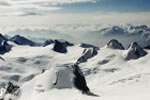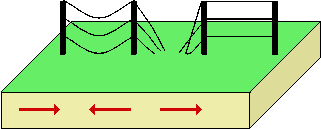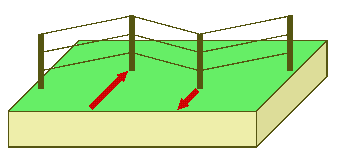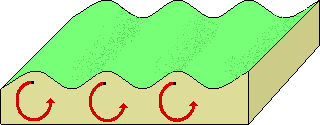


 |
 |
 |
An Earthquake is a sudden tremor or movement of the earth's crust, which originates naturally at or below the surface. The word natural is important here, since it excludes shock waves caused by French nuclear tests, man made explosions and landslides caused by building work.
There are two main causes of earthquakes.
Firstly, they can be linked to explosive volcanic eruptions; they are in fact very common in areas of volcanic activity where they either proceed or accompany eruptions.
Secondly, they can be triggered by Tectonic activity associated with plate margins and faults. The majority of earthquakes world wide are of this type.
Terminology
An earthquake can be likened to the effect observed when a stone is thrown into water. After the stone hits the water a series of concentric waves will move outwards from the center. The same events occur in an earthquake. There is a sudden movement within the crust or mantle, and concentric shock waves move out from that point. Geologists and Geographers call the origin of the earthquake the focus. Since this is often deep below the surface and difficult to map, the location of the earthquake is often referred to as the point on the Earth surface directly above the focus. This point is called the epicentre.
The strength, or magnitude, of the shockwaves determines the extent of the damage caused. Two main scales exist for defining the strength, the Mercalli Scale and the Richter Scale.
Earthquakes are three dimensional events, the waves move outwards from the focus, but can travel in both the horizontal and vertical plains. This produces three different types of waves which have their own distinct characteristics and can only move through certain layers within the Earth. Lets take a look at these three forms of shock waves.
Types of shockwaves
P-Waves
Primary Waves (P-Waves) are identical in character to sound waves. They are
high frequency, short-wavelength, longitudinal waves which can pass through
both solids and liquids. The ground is forced to move forwards and backwards
as it is compressed and decompressed. This produces relatively small displacements
of the ground.
P Waves can be reflected and refracted, and under certain circumstances can
change into S-Waves.

S-Waves
Secondary Waves (S-Waves) travel more slowly than P-Waves and arrive at any
given point after the P-Waves. Like P-Waves they are high frequency,
short-wavelength waves, but instead of being longitudinal they are transverse.
They move in all directions away from their source, at speeds which depend upon
the density of the rocks through which they are moving. They cannot move through
liquids. On the surface of the Earth, S-Waves are responsible for the sideways
displacement of walls and fences, leaving them 'S' shaped.

L-Waves
Surface Waves (L-Waves) are low frequency transverse vibrations with a long
wavelength. They are created close to the epicentre and can only travel through
the outer part of the crust. They are responsible for the majority of the building
damage caused by earthquakes. This is because L Waves have a motion similar
to that of waves in the sea. The ground is made to move in a circular motion,
causing it to rise and fall as visible waves move across the ground. Together
with secondary effects such as landslides, fires and tsunami these waves account
for the loss of approximately 10,000 lives and over $100 million per year.

Tectonic Earthquakes
Tectonic earthquakes are triggered when the crust becomes subjected to strain, and eventually moves. The theory of plate tectonics explains how the crust of the Earth is made of several plates, large areas of crust which float on the Mantle. Since these plates are free to slowly move, they can either drift towards each other, away from each other or slide past each other. Many of the earthquakes which we feel are located in the areas where plates collide or try to slide past each other.
The process which explains these earthquakes, known as Elastic Rebound Theory can be demonstrated with a green twig or branch. Holding both ends, the twig can be slowly bent. As it is bent, energy is built up within it. A point will be reached where the twig suddenly snaps. At this moment the energy within the twig has exceeded the Elastic Limit of the twig. As it snaps the energy is released, causing the twig to vibrate and to produce sound waves.
Perhaps the most famous example of plates sliding past each other is the San Andreas Fault in California. Here, two plates, the Pacific Plate and the North American Plate, are both moving in a roughly northwesterly direction, but one is moving faster than the other. The San Francisco area is subjected to hundreds of small earthquakes every year as the two plates grind against each other. Occasionally, as in 1989, a much larger movement occurs, triggering a far more violent 'quake'.
Major earthquakes are sometimes preceded by a period of changed activity. This might take the form of more frequent minor shocks as the rocks begin to move,called foreshocks , or a period of less frequent shocks as the two rock masses temporarily 'stick' and become locked together. Detailed surveys in San Francisco have shown that railway lines, fences and other longitudinal features very slowly become deformed as the pressure builds up in the rocks, then become noticeably offset when a movement occurs along the fault. Following the main shock, there may be further movements, called aftershocks, which occur as the rock masses 'settle down' in their new positions. Such aftershocks cause problems for rescue services, bringing down buildings already weakened by the main earthquake.
Volcanic Earthquakes
Volcanic earthquakes are far less common than Tectonic ones. They are triggered by the explosive eruption of a volcano. Given that not all volcanoes are prone to violent eruption, and that most are 'quiet' for the majority of the time, it is not surprising to find that they are comparatively rare.
When a volcano explodes, it is likely that the associated earthquake effects will be confined to an area 10 to 20 miles around its base, where as a tectonic earthquake may be felt around the globe.
The volcanoes which are most likely to explode violently are those which produce acidic lava. Acidic lava cools and sets very quickly upon contact with the air. This tends to chock the volcanic vent and block the further escape of pressure. For example, in the case of Mt Pelee, the lava solidified before it could flow down the sides of the volcano. Instead it formed a spine of solid rock within the volcano vent. The only way in which such a blockage can be removed is by the build up of pressure to the point at which the blockage is literally exploded out of the way. In reality, the weakest part of the volcano will be the part which gives way, sometimes leading to a sideways explosion as in the Mt St.Helens eruption.
When extraordinary levels of pressure develop, the resultant explosion can be devastating, producing an earthquake of considerable magnitude. When Krakatoa ( Indonesia, between Java and Sumatra ) exploded in 1883, the explosion was heard over 5000 km away in Australia. The shockwaves produced a series of tsunami ( large sea waves ), one of which was over 36m high; that's the same as four, two story houses stacked on top of each other. These swept over the coastal areas of Java and Sumatra killing over 36,000 people.
By contrast, volcanoes producing free flowing basic lava rarely cause earthquakes. The lava flows freely out of the vent and down the sides of the volcano, releasing pressure evenly and constantly. Since pressure doesn't build up, violent explosions do not occur.
We value
your ideas and suggestions. Please contact the
maintainer of this site.
This page
can be found at: http://www.geography-site.co.uk
Last update to
this statement was on:
February 22, 2006
© Copyright Geography Site